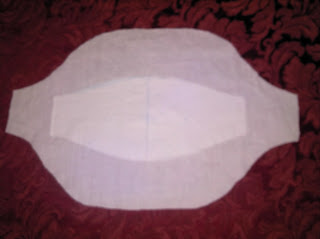1830s sleeve supports
Even though my sleeves have a pleated upper arm, the puff under that still requires shaping. I did not need a large puff so I measured my arm and that became my length. More fabric could be added here, but I wanted it to sit without being held in place with cords (tying them into place with cords was more common in the earlier part of the 1830s, I could imagine that when the sleeves began to be tighter at the top they may have become uncomfortable). I then calculated how large the puff would need to be to support the puff fabric without stretching it out too much. I then toiled it and tried it out... making adjustments as I went. The larger piece is gathered around the fullness, keeping the section that will go under the arm flat and smooth.
These are the final pattern shapes after toiling. The smaller shape is the inside and the larger is the gathered outside.
An unfilled puff upside down
An unfilled puff the right way round. I then filled the puffs with Cotton. To finish them off the ends, one end was folded into the other and it was then whip stitched down.
As you can see they are not very large, but still very effective.
1830s Chemisette
I love chemisettes and they tend to be an item that is often neglected by many members of the groups I am a part of. 4
- They provide protection for your garment from sweat stains around the neck and collars.
- They are easier to clean than a dress.
- They provide a level of period correct modesty for day wear.
- They are an easy way to change collars without whip stitching them directly to the dress.
- They just look really nice.
For mine I put three small 1/8" pin tucks on either side of the opening. It also has a cord string to close the neckline. The back is plain. The pattern had a basic collar, so I made a thin ruffle that I whip gathered on and trimmed with a lace edge.
1830s Shawl-Mantlet
The last item that I made to finish the impression was a matching cotton shawl-mantlet. These are an important outergarment of the time and come in a wide variety of shapes. They are not long and so they protect the sleeve from being crushed. I was amazed at how many exant cotton gowns still had their original matching capelette in online collections. I was provided with a basic pattern shaped off an original from a lady called Kay. She has a huge collection of exant garments and is wonderful at helping create authentic outfits. I toiled her pattern to fit me and then made it with the same cotton fabri as my dress, plain white cotton for lining and the same silk piping as I used on the dress. I also made my toile with scalloped edges, whereas the original only had a single scalop on the edge of each shoulder. I must admit they are very strange looking items and I doubt they would really provide your dress with any protection.
On my Manequin, over the collar..
Under the Collar















That's a very beautiful ensemble. I love to see how all the pretty details build up the whole ensemble to a proper period appearance! Fantastic!
ReplyDeleteSabine
Wonderful sleeve supports! I will have to remember this page for when I make my 1830s outfit!! You look fabulous in your ensemble!!!
ReplyDeleteBlessings!
Gina
Your capelet/mantlet was also called a pelerine.
ReplyDelete